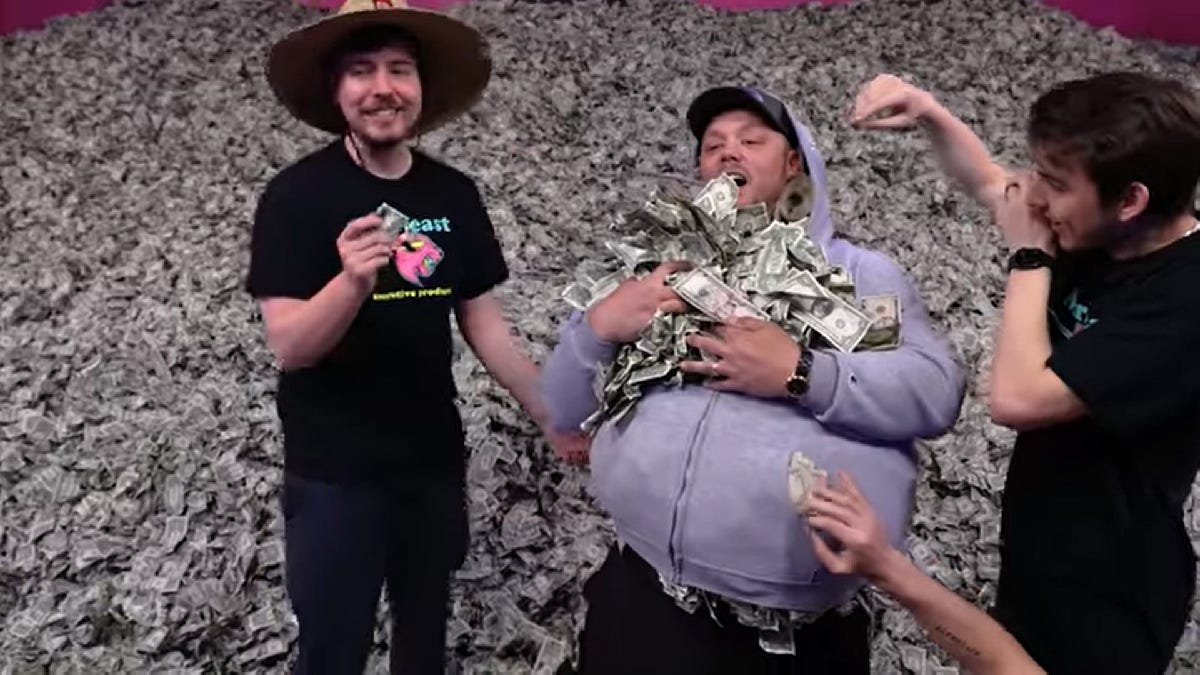The rise of the big budget YouTuber
Some YouTubers are now spending millions of dollars a year hiring out staff and building infrastructure.
Welcome! I'm Simon Owens and this is my media newsletter. You can subscribe by clicking on this handy little button:
Let’s jump right into it…
The rise of the big budget YouTuber
The YouTube channel Colin & Samir was recently given extraordinary access to the accounting books for MrBeast — who, for the uninitiated, is one of the most popular creators on YouTube. In a video uploaded this week, they revealed an astonishing figure: that MrBeast spends upward of $48 million a year on his channel.
What does he spend all this money on? Well anyone who’s even moderately familiar with MrBeast knows that each video is an elaborate stunt in which he usually gives away a large sum of money. In addition to his monster payouts that range anywhere from $10,000 to $1 million, he also employs a huge team to hand-build sets within massive warehouses that he owns.
Let’s put that $48 million in context: that’s more than the average Hollywood studio spends on a mainstream film. It’s more than TV networks spend on seasons of most reality TV shows.
YouTube has been historically thought of as the low-budget cousin to Hollywood, the place where a person can build an entire career with little more than a camera and a laptop. And while that’s still true for many creators, we’ve seen the emergence recently of the Big Budget YouTuber who’s willing to make substantial investments that extend into the millions of dollars.
Why is this happening? A few reasons, the first of which ties back to burnout. Most small YouTubers wear several hats in which they’re expected to create content, market their channel, and build out revenue streams, all by themselves. The 80-hour work weeks this requires can only be sustained for so long, so it makes sense that, once the channel has reached a certain size, the YouTuber will want to farm out these roles to other people so they can focus on their core competency of creating great content.
The second reason has to do with revenue diversification and building scalable media companies. In the early days of a YouTuber’s career, they’ll often rely mostly on YouTube AdSense for revenue generation, mainly because this allows them to offload business development so they can focus more on content production.
But once a channel reaches a certain size, then the YouTuber will often try to diversify their revenue so they’re no longer entirely dependent on YouTube’s capricious advertising payouts. Most large channels have expanded into sponsorships, merchandise, subscriptions, and even traditional Hollywood production. This requires a level of specialization and manpower that a YouTuber can’t achieve on their own.
YouTube recently revealed that it’s paying out upward of $10 billion a year to creators. If you divide that by median U.S. income of about $50,000, that means it’s supporting over 200,000 jobs. But not all of that money is going to front-of-camera creators. Instead, it’s increasingly being used to build out large production teams and media companies. The larger a YouTube channel gets, in other words, the more it starts to resemble a traditional Hollywood studio. We’re quickly approaching an era in which reality TV shows are almost indistinguishable from their YouTube counterparts.
Is the creator economy "tax" worth it?
In case you haven’t noticed, there’s been a veritable explosion of creator economy startups over the last few years, and while their offerings vary, they’ve all pretty much settled on the same business model: taking a percentage cut of a creator’s revenue.
But is that percentage cut actually worth the price of admission? I dive into answering that question over here.
Quick hits
TikTok has become a huge driver of book sales. [Publishers Weekly]
Are book publishers gouging libraries through ebook licensing? [New Yorker]
LinkedIn is “investing” $25 million into creators. [Tubefilter] This seems like a small drop in the bucket compared to what other platforms are paying out to creators. I wonder if any creators are making good money from posting their courses to LinkedIn learning.
Substack continues to think outside the box in terms of what can be delivered in newsletter format. Lately it's been experimenting with both comics and serialized books. [Publishers Weekly]
Patreon bought a tech recruiting company. [WTVB] Maybe this is common, but I've never seen a tech company acquire an entire recruiting firm just to speed up its own internal hiring of engineers.
A profile of Salem Media Group, a company that owns over 100 radio stations and fuels a huge portion of the Covid misinformation that's killed thousands of Americans. [NPR]
This is where you come in
February 23, 2022. That’ll be the two year anniversary of me launching the paid edition of my newsletter. It’s also the deadline I’ve given myself for turning it into a sustainable business. If it doesn’t reach sustainability by that date, then there’s a good chance that I’ll have to drastically reduce production and focus on getting a traditional job.
There’s only way to stop that from happening: by becoming a paid subscriber. Subscribe at the link below and get 30% off for your first year:
ICYMI: Why Ira Glass is the godfather of modern podcasting
Nearly every narrative podcast can trace its roots back to This American Life.
Want to chat with me directly?
I have a private Facebook group, and it’s probably the platform where I’m most responsive in terms of answering questions and chiming in on media industry discussions. You can join over here: [Facebook]
Do you like this newsletter?
Then you should subscribe here:
Simon Owens is a tech and media journalist living in Washington, DC. Follow him on Twitter, Facebook, or LinkedIn. Email him at simonowens@gmail.com. For a full bio, go here.



